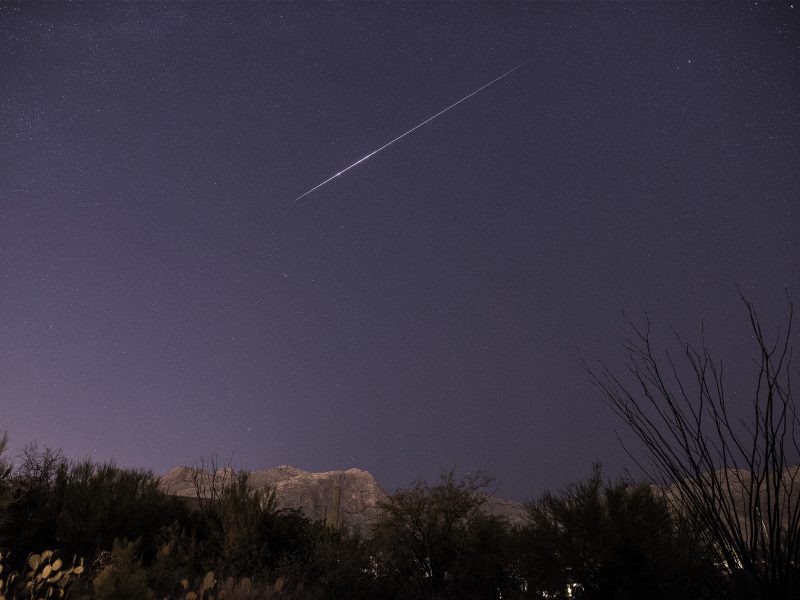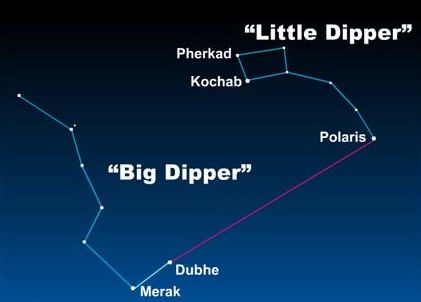Start watching tonight – December 17, 2019 – for meteors in the annual Ursid meteor shower. This shower runs from about December 17 to 26 each year. It typically peaks around the December solstice, which, in 2019, comes on December 21 or 22, depending on your time zone. The shower’s peak is probably the morning of December 22, but any of the next few mornings should yield some Ursids as well. Then, after the solstice and the shower’s peak, keep watching. You might catch some!
Generally, the Ursids are a low-key affair, offering perhaps as many as 5 to 10 meteors per hour in a dark sky. In rare instances, bursts of 100 or more meteors per hour have been observed at times over the past century.
The chart at the top of the page shows the Big and Little Dipper asterisms – in the constellations Ursa Major and Ursa Minor – for whom the Ursid meteor shower is named. If you look from a Northern Hemisphere location around the time of the solstice, you’ll find the Big Dipper well up in the north-northeast at around 1 a.m. That’s about the time of night you’ll want to start watching this meteor shower.
In 2019, at this shower’s peak, the moon is in waning phase. It’ll be bright in the sky on the mornings of December 18 or 19, but, by the time of the Ursids’ peak on the mornings of December 22 or 23, the moon will be a thin crescent. It won’t greatly intrude on what’s usually a low-key spattering of Ursid meteors on the mornings of the peak.
Read more: Year’s farthest lunar perigee on December 18
EarthSky lunar calendars are cool! They make great gifts. Order now. Going fast!

Ursid fireball! A fireball is just a very bright meteor. Eliot Herman in Tucson caught this one on December 18, 2016.
This shower isn’t a great one for the Southern Hemisphere. It’s just too far north on the sky’s dome for its radiant point to be easily visible from temperate latitudes in the Southern Hemisphere. As you may know, all meteors in annual showers have radiant points on our sky’s dome; the showers typically take their names from the constellations in which their radiants lie. If you trace the paths of the slow-moving Ursid meteors backward, they appear to come from the section of sky marked by the Little Dipper star Kochab.
On the other hand, the Little Dipper is circumpolar (out all night) for far-northerly latitudes. From there, you’ll find the star Kochab below Polaris, the North Star, at nightfall. Kochab (and all the Little Dipper stars) circle Polaris in a counterclockwise direction throughout the night, with this star reaching its high point for the night in the hours before dawn. And that’s important for meteor-watching, because the higher the radiant climbs in your sky, the more meteors you’re likely to see. Thus for the Ursids – as for so many meteors showers – the best time to watch is in the hours before dawn.
Read more: Kochab and Pherkad guard the North Celestial Pole
Do you love stargazing? Order your EarthSky Planisphere today!

Ursid meteors radiate from near the star Kochab in the Little Dipper. The star Polaris is also part of the Little Dipper. Can’t find the Little Dipper? Use the Big Dipper! No matter what time of year you look, the two outer stars in the Big Dipper’s bowl always point to Polaris, which marks the end of the handle of the Little Dipper.
Bottom line: If you want to watch the Ursids, find a country location where you can camp out. Dress warmly! And plan to spend several hours reclining under a dark sky. The predawn hours are usually the most favorable.
Read more: Ursid meteors peak around the solstice
from EarthSky https://ift.tt/2S5lQCd
Start watching tonight – December 17, 2019 – for meteors in the annual Ursid meteor shower. This shower runs from about December 17 to 26 each year. It typically peaks around the December solstice, which, in 2019, comes on December 21 or 22, depending on your time zone. The shower’s peak is probably the morning of December 22, but any of the next few mornings should yield some Ursids as well. Then, after the solstice and the shower’s peak, keep watching. You might catch some!
Generally, the Ursids are a low-key affair, offering perhaps as many as 5 to 10 meteors per hour in a dark sky. In rare instances, bursts of 100 or more meteors per hour have been observed at times over the past century.
The chart at the top of the page shows the Big and Little Dipper asterisms – in the constellations Ursa Major and Ursa Minor – for whom the Ursid meteor shower is named. If you look from a Northern Hemisphere location around the time of the solstice, you’ll find the Big Dipper well up in the north-northeast at around 1 a.m. That’s about the time of night you’ll want to start watching this meteor shower.
In 2019, at this shower’s peak, the moon is in waning phase. It’ll be bright in the sky on the mornings of December 18 or 19, but, by the time of the Ursids’ peak on the mornings of December 22 or 23, the moon will be a thin crescent. It won’t greatly intrude on what’s usually a low-key spattering of Ursid meteors on the mornings of the peak.
Read more: Year’s farthest lunar perigee on December 18
EarthSky lunar calendars are cool! They make great gifts. Order now. Going fast!

Ursid fireball! A fireball is just a very bright meteor. Eliot Herman in Tucson caught this one on December 18, 2016.
This shower isn’t a great one for the Southern Hemisphere. It’s just too far north on the sky’s dome for its radiant point to be easily visible from temperate latitudes in the Southern Hemisphere. As you may know, all meteors in annual showers have radiant points on our sky’s dome; the showers typically take their names from the constellations in which their radiants lie. If you trace the paths of the slow-moving Ursid meteors backward, they appear to come from the section of sky marked by the Little Dipper star Kochab.
On the other hand, the Little Dipper is circumpolar (out all night) for far-northerly latitudes. From there, you’ll find the star Kochab below Polaris, the North Star, at nightfall. Kochab (and all the Little Dipper stars) circle Polaris in a counterclockwise direction throughout the night, with this star reaching its high point for the night in the hours before dawn. And that’s important for meteor-watching, because the higher the radiant climbs in your sky, the more meteors you’re likely to see. Thus for the Ursids – as for so many meteors showers – the best time to watch is in the hours before dawn.
Read more: Kochab and Pherkad guard the North Celestial Pole
Do you love stargazing? Order your EarthSky Planisphere today!

Ursid meteors radiate from near the star Kochab in the Little Dipper. The star Polaris is also part of the Little Dipper. Can’t find the Little Dipper? Use the Big Dipper! No matter what time of year you look, the two outer stars in the Big Dipper’s bowl always point to Polaris, which marks the end of the handle of the Little Dipper.
Bottom line: If you want to watch the Ursids, find a country location where you can camp out. Dress warmly! And plan to spend several hours reclining under a dark sky. The predawn hours are usually the most favorable.
Read more: Ursid meteors peak around the solstice
from EarthSky https://ift.tt/2S5lQCd

Aucun commentaire:
Enregistrer un commentaire